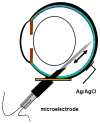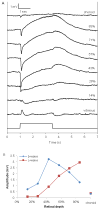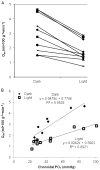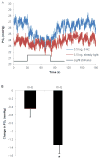Oxygen consumption and distribution in the Long-Evans rat retina
- PMID: 22828049
- PMCID: PMC3437263
- DOI: 10.1016/j.exer.2012.07.004
Oxygen consumption and distribution in the Long-Evans rat retina
Abstract
The purpose of this study was to investigate the oxygen distribution and consumption in the pigmented Long-Evans rat retina in vivo during dark and light adaptation, and to compare these results to previous work on cat and albino rat. Double-barreled microelectrodes recorded both intraretinal PO(2) depth profiles and the electroretinogram (ERG), which was used to identify the boundaries of the retina. Light adaptation decreased photoreceptor oxygen consumption per unit volume (Q(av)) from 3.0 ± 0.4 ml·100 g(-1) min(-1) (mean ± SEM) in darkness to 1.8 ± 0.2 ml·100 g(-1) min(-1) and increased minimum outer retinal PO(2) at the inner segments (P(min)) from 17.4 ± 3.0 to 29.9 ± 5.3 mmHg. The effects of light on outer retinal PO(2) and Q(av) were similar to those previously observed in cat, monkey, and albino rats; however, dark-adapted P(min) was higher in rat than cat. The parameters derived from fitting the oxygen diffusion model to the rat data were compared to those from cat. Oxygen consumption of the inner segments (Q(2)) and choroidal PO(2) (P(C)) in rat and cat were similar. P(min) was higher in rat than in cat for two reasons: first, rat photoreceptors have a shorter oxygen consuming region; and second, the retinal circulation supplied a greater fraction of consumed oxygen to rat photoreceptors. The average PO(2) across the inner retina (P(IR)) was not different in dark adaptation (25.4 ± 4.8 mmHg) and light adaptation (28.8 ± 5.4 mmHg) when measured from PO(2) profiles. However, with the microelectrode stationary at 9-18% retinal depth, a small consistent decrease in PO(2) occurred during illumination. Flickering light at 6 Hz decreased inner retinal PO(2) significantly more than an equivalent steady illumination, suggesting that changes in blood flow did not completely compensate for increased metabolism. This study comprehensively characterized rat retinal oxygenation in both light and dark, and determined the similarities and differences between rat and cat retinas.
Copyright © 2012 Elsevier Ltd. All rights reserved.
Figures






Similar articles
-
Oxygen distribution and consumption in the macaque retina.Am J Physiol Heart Circ Physiol. 2007 Sep;293(3):H1696-704. doi: 10.1152/ajpheart.00221.2007. Epub 2007 Jun 8. Am J Physiol Heart Circ Physiol. 2007. PMID: 17557923
-
Oxygen distribution and consumption in the cat retina during normoxia and hypoxemia.J Gen Physiol. 1992 Feb;99(2):177-97. doi: 10.1085/jgp.99.2.177. J Gen Physiol. 1992. PMID: 1613482 Free PMC article.
-
Oxygen consumption in the inner and outer retina of the cat.Invest Ophthalmol Vis Sci. 1995 Mar;36(3):542-54. Invest Ophthalmol Vis Sci. 1995. PMID: 7890485
-
Oxygen distribution and consumption within the retina in vascularised and avascular retinas and in animal models of retinal disease.Prog Retin Eye Res. 2001 Mar;20(2):175-208. doi: 10.1016/s1350-9462(00)00027-6. Prog Retin Eye Res. 2001. PMID: 11173251 Review.
-
Retinal degeneration and local oxygen metabolism.Exp Eye Res. 2005 Jun;80(6):745-51. doi: 10.1016/j.exer.2005.01.018. Exp Eye Res. 2005. PMID: 15939030 Review.
Cited by
-
Bcl-xL-mediated remodeling of rod and cone synaptic mitochondria after postnatal lead exposure: electron microscopy, tomography and oxygen consumption.Mol Vis. 2012;18:3029-48. Epub 2012 Dec 20. Mol Vis. 2012. PMID: 23288995 Free PMC article.
-
Quantitative retinal and choroidal blood flow during light, dark adaptation and flicker light stimulation in rats using fluorescent microspheres.Curr Eye Res. 2013 Feb;38(2):292-8. doi: 10.3109/02713683.2012.756526. Epub 2013 Jan 14. Curr Eye Res. 2013. PMID: 23317112 Free PMC article.
-
Diabetes-Induced Changes of the Rat ERG in Relation to Hyperglycemia and Acidosis.Curr Eye Res. 2024 Jan;49(1):53-61. doi: 10.1080/02713683.2023.2264544. Epub 2024 Jan 3. Curr Eye Res. 2024. PMID: 37756520 Free PMC article.
-
Quantitative Volumetric Analysis of Retinal Ischemia with an Oxygen Diffusion Model and OCT Angiography.Ophthalmol Sci. 2024 Jul 19;4(6):100579. doi: 10.1016/j.xops.2024.100579. eCollection 2024 Nov-Dec. Ophthalmol Sci. 2024. PMID: 39263580 Free PMC article.
-
Age dependence of retinal vascular plexus attenuation in the triple transgenic mouse model of Alzheimer's disease.Exp Eye Res. 2022 Jan;214:108879. doi: 10.1016/j.exer.2021.108879. Epub 2021 Dec 10. Exp Eye Res. 2022. PMID: 34896306 Free PMC article.
References
-
- Ahmed J, Braun RD, Dunn R, Jr, Linsenmeier RA. Oxygen distribution in the macaque retina. Invest Ophthalmol Vis Sci. 1993;34:516–521. - PubMed
-
- Alder VA, Yu DY, Cringle SJ. Vitreal oxygen tension measurements in the rat eye. Exp Eye Res. 1991;52:293–299. - PubMed
-
- Barnett V, Lewis T. Outliers in Statistical Data. John Wiley & Sons; New York: 1978.
-
- Bill A, Sperber GO. Aspects of oxygen and glucose consumption in the retina: effects of high intraocular pressure and light. Graefes Arch Clin Exp Ophthalmol. 1990;228:124–127. - PubMed
Publication types
MeSH terms
Substances
Grants and funding
LinkOut - more resources
Full Text Sources
Miscellaneous

